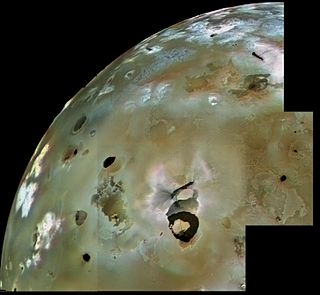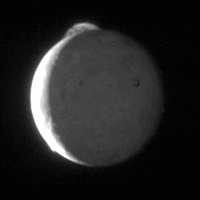
Loki Patera is the largest volcanic depression on Jupiter's moon Io, 202 kilometres (126 mi) in diameter. It contains an active lava lake, with an episodically overturning crust. The level of activity seen is similar to a superfast spreading mid-ocean ridge on Earth. Temperature measurements of thermal emission at Loki Patera taken by Voyager 1's Infrared Interferometer Spectrometer and Radiometer (IRIS) instrument were consistent with sulfur volcanism.

Reiden Patera is a volcanic feature on Jupiter's moon Io. It was first detected by the Galileo SSI Team during the spacecraft Galileo's first orbit around Jupiter, initially detected as a hotspot. It was once thought that the activity there had stopped or waned below the limits of the spacecraft's Solid State Imager or Near-Infrared Mapping Spectrometer. However, it was noticed in 2002 that Reiden Patera has darkened considerably since the 24th orbit of Galileo. It has been spouting bright red pyroclastic deposits of its own. It is located at 13.4°S 235.45°W and is 70 kilometers in diameter. It is named after a Japanese thunder god. Asha Patera can be found to the east, and Kami-Nari Patera can be found to the north.

Amaterasu Patera is a patera, a complex crater with scalloped edges, on Jupiter's moon Io. It is one of the darkest features on Io, and the measurement of its thermal spectrum helped to support an anticorrelation between albedo and temperature for Ionian hotspots. The feature has darkened further since the first orbit around Jupiter by the Galileo spacecraft. It is 100 kilometers in diameter and located at 38.1°N 306.5°W. It was named after the Japanese sun goddess Amaterasu. To the north are Kinich Ahau Patera and Dazhbog Patera, and to the west are Manua Patera and Fuchi Patera.

Fuchi Patera is a patera, or a complex crater with scalloped edges, on Jupiter's moon Io. It is approximately 66 kilometers in diameter and is located at 28.4°N 327.6°W. It is named after the Ainu fire goddess, Kamuy Fuchi. Its name was adopted by the International Astronomical Union in 1979. Manua Patera is located north-northeast, and Amaterasu Patera is located northeast.

Manua Patera is a patera, or a complex crater with scalloped edges, on Jupiter's moon Io. It is about 110 kilometers in diameter and is located at 35.78°N 321.73°W. It is named after the Hawaiian sun god Manua. Its name was adopted by the International Astronomical Union in 1979. To the southwest is Fuchi Patera, and to the east is Amaterasu Patera.

Kinich Ahau Patera is a patera, or a complex crater with scalloped edges, on Jupiter's moon Io. It is about 45 kilometers in diameter and is located at 49.35°N 310.25°W. It is named after the Mayan sun god Kinich Ahau. Dazhbog Patera is located northeast, Amaterasu Patera is located south-southeast, and Manua Patera can be found southwest.

Monan Patera is a patera, or a complex crater with scalloped edges, on Jupiter's moon Io. It is about 137 kilometers in diameter and is located at 19.82°N 104.81°W. It is named after Monan, a god in Brazilian mythology that destroyed the world with fire and floods. Its name was adopted by the International Astronomical Union in 1997.

Ah Peku Patera is a patera, or a complex crater with scalloped edges, on Jupiter's moon Io. It is 85 kilometers in diameter and is located at 10.3°N 107°W. It is named after the Mayan thunder god Ah Peku. Its name was adopted by the International Astronomical Union in 2006. Ah Peku Patera is located on the south end of Monan Mons, north of which is Monan Patera. The eruptive centers Amirani and Maui can be found northwest, as well as Maui Patera. Gish Bar Patera is located toward the northeast. Ah Peku Patera was first detected by the spacecraft Galileo's Solid State Imager and Near-Infrared Mapping Spectrometer. It is considered an active hot spot.

Gish Bar Patera is a patera, or a complex crater with scalloped edges, on Jupiter's moon Io. It is 106.3 by 115.0 kilometers and 9,600 km2 in area. It is located at 16.18°N 90.26°W. It is named after the Babylonian sun god Gish Bar. Its name was approved by the International Astronomical Union in 1997. It is located at the southern base of Gish Bar Mons, an 11-kilometer-high mountain. To the northeast is Skythia Mons, and to the east is Monan Mons, at the north and south ends of which are Monan Patera and Ah Peku Patera.

Estan Patera is a patera, or a complex crater with scalloped edges, on Jupiter's moon Io. It is 95 kilometers in diameter and located at 21.53°N 87.59°W. It is named after the Hittite sun god Estan. Its name was adopted by the International Astronomical Union in 2006. It is located at the northern base of the 11-kilometer mountain Gish Bar Mons. Located west-northwest is Skythia Mons, and to the southwest is Monan Mons, at the northern and southern ends of which are Monan Patera and Ah Peku Patera.

Shango Patera is a patera, or a complex crater with scalloped edges, on Jupiter's moon Io. It is about 90 kilometers in diameter and is located at 32.35°N 100.52°W. It is named after the Yoruba thunder god Shango. Its name was approved by the International Astronomical Union in 2000. It is located north of Skythia Mons. To the southwest is the eruptive center Amirani, and to the southeast are Gish Bar Patera, Gish Bar Mons, and Estan Patera.

Maui Patera is a patera, or a complex crater with scalloped edges, on Jupiter's moon Io. It is about 38 kilometers in diameter and is located at 16.61°N 124.23°W. It is named after Māui, a Hawaiian demigod that sought fire from Mafuike. Its name was approved by the International Astronomical Union in 1979. It is located southwest of the eruptive center Maui, south of Euxine Mons, and southwest of the volcano Amirani. Due east are Monan Patera, Monan Mons, and Ah Peku Patera.

Babbar Patera is a patera, or a complex crater with scalloped edges, on Jupiter's moon Io. It is about 86 kilometers in diameter and is located at 39.8°S 272°W. It is named after a Sumerian sun god, and its name was approved by the International Astronomical Union in 1979. Some scarps near Babbar Patera may represent faults. Immediately south of Babbar Patera is the plateau Lyrcea Planum, and further south is Svarog Patera. To the east is the mountain Egypt Mons.

Pyerun Patera is a patera, or a complex crater with scalloped edges, on Jupiter's moon Io. It is about 57 kilometers in diameter and is located at 55.65°S 251.06°W. It is named after the Slavonic god of thunder, Pyerun. The name was adopted by the International Astronomical Union in 1985. West of Pyerun Patera is Mithra Patera, and to the east is the mesa Epaphus Mensa. To the northeast is Epaphus Mensa, and to the northwest are the mountain Silpium Mons and Svarog Patera.

Mithra Patera is a patera, or a complex crater with scalloped edges, on Jupiter's moon Io. It is about 34 kilometers in diameter and is located at 59.04°S 266.48°W. It is named after the Persian god of light, Mithra. Its name was adopted by the International Astronomical Union in 1985. To the north is Silpian Mons, and to the east is Pyerun Patera. Located southwest is Viracocha Patera.

Viracocha Patera is a patera, or a complex crater with scalloped edges, on Jupiter's moon Io. It is about 61 kilometers in diameter and is located at 61.75°S 280.07°W. It is named after the Quechua creator god Viracocha. The name was adopted by the International Astronomical Union in 1979. Viracocha Patera is a Voyager spacecraft-detected hot spot. To Viracocha Patera's east-northeast is Mithra Patera, and to the northeast is the mountain Silpium Mons.

Egypt Mons is a mountain on Jupiter's moon Io. It is 10 kilometers in height, making it the 11th tallest mountain on Io, and taller than Mount Everest. Although the U.S. Geological Survey gives a diameter of 193.7 kilometers, the Io Mountain Database gives a length of 133.8 kilometers and a width of 146.0 kilometers. It is a Flatiron Massif mountain, meaning it has a rugged, irregular appearance and complex surface morphology. It is 9792 km2 in area and its center located at 41.49°S 257.6°W. It has a steep, north-facing scarp. Egypt Mons is named for Egypt, because that is the place where Io ended her wanderings in the mythology. Its name was adopted by the International Astronomical Union in 1997. To the northwest is Babbar Patera, and southeast is Hermes Mensa. Svarog Patera can be found to the southwest.

Silpium Mons is a mountain on Jupiter's moon Io. It is 5.6 kilometers in height, 113 kilometers in length, and 79.7 kilometers in width. It covers an area of 7073 km2. It is a striated ridge, meaning it is an elevated structure dominated by one or more prominent linear or arcuate rises. It is named after a location in Greece where the mythological Io died of grief. Its name was adopted by the International Astronomical Union in 1979. It is located at 52.71°S 272.34°W, south of Svarog Patera, north of Mithra Patera, and northeast of Viracocha Patera. Its proximity to Svarog and Viracocha Paterae has been suggested to be evidence for a structural relationship between mountains and calderas on Io.

Patera is an irregular crater, or a complex crater with scalloped edges on a celestial body. Paterae can have any origin, although majority of them were created by volcanism. The term comes from Latin language, where it refers to a shallow bowl used in antique culture.














